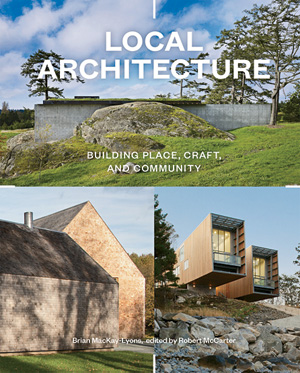Ghost Stories
Thirteen times during a 17-year period, architect and educator Brian MacKay-Lyons hosted a multi-day gathering of his peers, students, and fellow travelers in the ad hoc movement to reestablish architecture's roots in local soil. Held at his family farm in Lower Kingsburg, Nova Scotia, not far from where Samuel de Champlain established the first French settlement in North America in 1604, these events combined talks by an international coterie of practitioners and critics with the construction of a design-build project by MacKay-Lyons' students at Dalhousie University in Halifax. Bridging the gap between thinking and doing, the academy and the profession, these so-called Ghost Architectural Laboratories were storied affairs at which participants, braving the sometimes harsh elements of the North Atlantic, bonded over late-night chats and shared bottles of whiskey.

Local Architecture chronicles the 13th and last Ghost Lab, held in 2011. The book shows the work of the 18 architects who presented at the gathering—including Deborah Berke, Marlon Blackwell, Rick Joy, Glenn Murcutt, Patricia Patkau, Brigitte Shim, and MacKay-Lyons—as well as that of the Ghost Lab design-build interns that MacKay-Lyons oversaw in previous years. It also features the keynote talks by Kenneth Frampton and Juhani Pallasmaa, a discussion between Murcutt and Pallasmaa, and a series of essays by Robert McCarter, Peter Buchanan, Ingerid Helsing Almaas, Christine Macy, and Essy Baniassad. An introduction by Thomas Fisher provides an excellent overview of the event and identifies its key themes of reconnecting architecture to place, craft, and community. Fisher quotes MacKay-Lyons as saying, “I'm just trying to see the world whole,” a clear and succinct explanation of his approach to design and life.
Though working independently and in far-flung locations, MacKay-Lyons and the other architects who participated in Ghost Lab over the years have advanced a design philosophy that responds to the peculiarities of place without being slavish to them. Climate, resources, and context inform their projects but don't limit them. These architects share an attitude and approach to their work, but aren't interested in establishing a formal movement. They aren't the Congress for the New Urbanism (CNU).
Although MacKay-Lyons and the Ghost Lab gang talk about the need to understand local building traditions and respect old ways of doing things, as do the New Urbanists, they don't historicize design. Building on old knowledge, they create architecture that is modern and forward-looking. While their periodic gatherings didn't generate the near-religious fervor that often emanates from CNU events, they seem to have had the rambling but intellectually nimble quality of a good college seminar. These architects aren't interested in writing manifestos. Instead, they put together Local Architecture, a book that presents a range of projects and ideas that quietly impress us with their conviction and quality.

Post a comment to this article
Report Abusive Comment